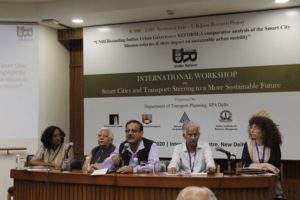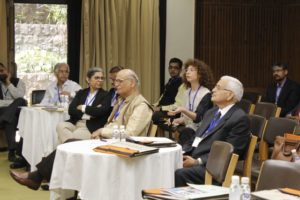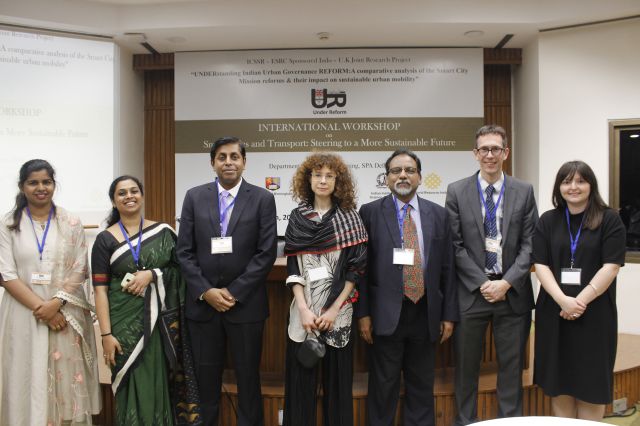by Louise Reardon
Last week the project team were in New Delhi to launch our policy briefing Where Next for Urban Transport Policy? Drawn from our research findings, the report provides ten recommendations for developing future urban transport reforms – be these under the next iteration of a Smart Cities Mission, NITI Aayog’s National Urban Transportation Policy or a new initiative. Our Executive Summary provides quick access to each of the recommendations, but in brief they span three broad themes; the role of new institutional arrangements in delivering reforms; the processes of programme delivery; and the role of ‘Mission’ style programmes in enabling sustainable urban transport policy.
 From the outset, the project sought to engage stakeholders at the city, state and central government levels, and after three workshops and over 90 interviews, we were confident we captured the key issues, albeit recognising the limitations of the research. That being said, it was still reassuring to have a welcome reception for the Report in New Delhi, where our findings chimed with the experiences of many Smart Cities Mission stakeholders in the room. After an initial overview of the project’s findings, the launch centred around two panel discussions. The first focusing on issues related to the use of Special Purpose Vehicles (SPVs) in the delivery of the Smart Cities Mission, with the second focusing on first hand experiences of the impact of the Mission on the ground.
From the outset, the project sought to engage stakeholders at the city, state and central government levels, and after three workshops and over 90 interviews, we were confident we captured the key issues, albeit recognising the limitations of the research. That being said, it was still reassuring to have a welcome reception for the Report in New Delhi, where our findings chimed with the experiences of many Smart Cities Mission stakeholders in the room. After an initial overview of the project’s findings, the launch centred around two panel discussions. The first focusing on issues related to the use of Special Purpose Vehicles (SPVs) in the delivery of the Smart Cities Mission, with the second focusing on first hand experiences of the impact of the Mission on the ground.
It was clear from the discussions that followed, that the Smart Cities Mission raises profound questions as to who is responsible for urban transport planning in Indian cities, and who should be responsible. We heard how, in echoes of our own findings, SPVs were not only delivering the Mission’s projects, but making policy decisions. SPVs were deciding which projects to prioritise for delivery, and what they should look like. There was concern that the SPVs were therefore working in parallel to, rather than in support of, democratically constituted Urban Local Bodies in some places. The fact that SPVs have been set up as limited companies, rather than under the umbrella of the Urban Local Body, was seen to further encourage separation and risk the commercialisation of urban planning and development to boot.
 However, it was acknowledged that it does not have to be this way; SPVs can offer much needed support to Urban Local Bodies. There was broad agreement that SPVs could be effective in the implementation of projects (pieces of infrastructure for example), acting as a delivery arm of the Urban Local Bodies. It was recognised that they provide a mechanism for recruiting targeted expertise (lacking at the municipal level), alongside providing clearer financial accountability, which can in turn provide an impetus for quicker project delivery. However, what we find on the ground, and echoed in the workshop discussions, is that disconnects between the planning and delivery phases of Mission delivery, coupled with the pressure to deliver quickly (which makes consultation and engagement patchy), leads to a fragmented relationship between Urban Local Bodies and SPVs in many instances.
However, it was acknowledged that it does not have to be this way; SPVs can offer much needed support to Urban Local Bodies. There was broad agreement that SPVs could be effective in the implementation of projects (pieces of infrastructure for example), acting as a delivery arm of the Urban Local Bodies. It was recognised that they provide a mechanism for recruiting targeted expertise (lacking at the municipal level), alongside providing clearer financial accountability, which can in turn provide an impetus for quicker project delivery. However, what we find on the ground, and echoed in the workshop discussions, is that disconnects between the planning and delivery phases of Mission delivery, coupled with the pressure to deliver quickly (which makes consultation and engagement patchy), leads to a fragmented relationship between Urban Local Bodies and SPVs in many instances.
In looking beyond the Smart Cities Mission, policymakers therefore need to acknowledge the plethora of complex networks that new institutions such as SPVs, are being layered on to. This requires, especially in a federal system such as India’s, a focus on the institutional specificities of each city. The fundamental co-ordination challenges and power struggles that go on between agencies will continue to undermine progress to a more integrated set of transport policies and actions if they remain unaddressed. One of the challenges for politicians is whether they will recognise the need to invest time in seemingly bureaucratic reform processes. It is easy to see why the Smart Cities Mission, delivered through SPVs, might be a more appealing choice. Our workshop suggests that there is very limited faith that the easy choice is the right choice.

